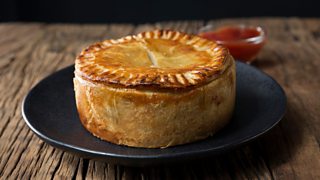Is the pasty really Cornish?
The Food Programme celebrated a food that the Cornish – and perhaps the whole of the UK – take enormous pride in. The pasty.
But is this edible emblem of Cornishness really Cornish? The answer may not be as simple as we think…
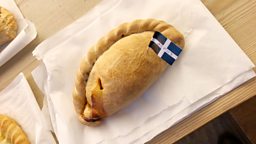
What is a “Cornish pasty”?
The Cornish are so protective of their pasty, it was given Protected Geographical Indication Status by the EU in 2011.
To qualify, a pasty must be made in Cornwall, have savoury pastry, and only contain beef, potato, swede (which the Cornish call turnip), onion, and salt and pepper for seasoning. Also, the ingredients have to be uncooked when it’s assembled, and it must have a characteristic D shape with a crimped crust on one side – not on the top.
-
![]()
The Food Programme: Is the Pasty Really Cornish?
Dr Polly Russell and Sheila Dillon talk to pasty makers from around the world.
This PGI status means you can’t make a pasty outside of the county and call it a Cornish pasty.
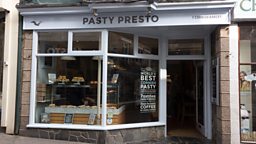
What does the pasty mean to the Cornish?
There’s no doubt about it, pasties are big business in Cornwall.
Did you know you won’t find a Greggs in Cornwall? Although they made a quiet attempt to open a shop in the summer of 2018, it then closed in September 2019.
It’s a food item that’s hugely important to the local people, says Ruth Huxley from the : “It’s worth about 20% of the whole of the value of the food and drink economy of Cornwall and about 300 million pounds worth of business is conducted by the pasty producers.”
The pasty is the mainstay of many Cornish baking businesses and, although the county has a largely seasonal economy, most of the jobs in the pasty industry keep going all year round. Locals remain loyal to the many family-run bakeries that still exist in the county. (Did you know you won’t find a Greggs in Cornwall? Although they made a quiet attempt to open a shop in the summer of 2018, it then closed in September 2019, having survived a little over a year.)
The pasty is so inherently Cornish, and so central to the county’s industry and identity, it must have been invented there, right? Well actually, it’s up for debate.
The roots of the pasty
Dr Polly Russell, the curator of contemporary politics and public life at the , says the roots of the pasty aren’t actually Cornish at all.
The origin of the word pasty is from the Old French “paste” meaning “pastry”. And it has a very long history: we know that there are references to pasties in texts from around the 1300s. There’s another early reference from Plymouth, in 1509, to a cook being paid ten shillings for his labour in making pasties. A little later, there’s a reference in a letter written by Jane Seymour – Henry VIII’s third wife. She writes about sending pasties to a friend and hoping they arrive without being damaged.
In Samuel Pepys’s famous diary from the mid 17th Century he refers to a “a damned venison pasty, that stunk like a devil.” And an eighteenth-century agriculturalist, William Ellis, wrote The Country Housewife's Family Companion in which he describes a Hertfordshire housewife’s way to make “two cornered pasties” in the “shape of a turnover.” These were being made to feed labourers on a farm at harvest time.
The truth is, pasties were being eaten by working people all over the country.
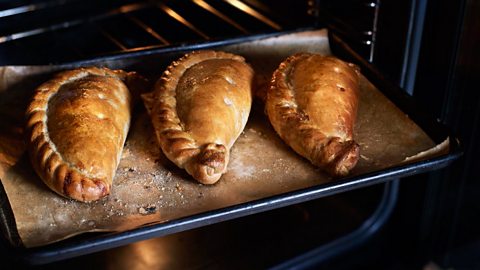
How to make the perfect pasty
Pasty champions share the best methods for pasties and what constitutes a Cornish pasty.
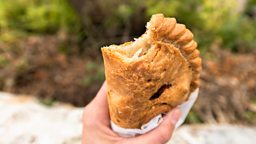
A meal for the miners
It probably wasn’t until the tin mining industry took off in Cornwall that the county came to adopt the food stuff for itself.
The pasty's unique shape meant it was a complete meal that could be carried easily and eaten without cutlery.
Its unique shape meant it was a complete meal that could be carried easily and eaten without cutlery.
And the dense pastry would keep the pasty’s contents warm for several hours, even down a mine.
The agricultural revolution meant that farmers started producing fodder crops, which in Cornwall included turnips. That fodder crop was then used in the pasties eaten by the miners and farm labourers.
One Lord Edward Craggs-Elliot meticulously kept records of his land and what was grown on it, and one archive record from 1777 describes a crop rotation that includes turnips. This early record of the vegetable being cultivated in Cornwall could signal the start of the Cornish pasty as we know it.
-
![]()
Poldark parlance: 14 Cornish phrases and what they mean
Cornish has been experiencing a recent revival. Here are a few of our favourite phrases.

Pasties around the world
Cornwall became the mining capital of the world, and when members of that mining community went all over the globe – they took the pasty with them.
Cornwall became the mining capital of the world, and when members of that mining community went all over the globe – they took the pasty with them.
In 1824 the very first Cornish miners travelled out to Mexico, and settled in the derelict town of Real del Monte in Hidalgo, where they went to work clearing mines. And in this small town, about 9,000 feet above sea level, the wives did what they had done back in Cornwall, which was make pasties. These pasties, which are much smaller than their Cornish grandparent, live on today.
The most traditional one contains ground beef, onion, potato, and parsley – with a hint of chilli. In fact, the pasty is so central to the culture, Real del Monte now hosts a three-day International Pasty Festival each October.
“This is replicated not just in Mexico but with migrants moving to America, to Minnesota, to Canada, to Australia,” says Polly Russell. “Anyone who travels to many of those places now will see foods which are incredibly reminiscent and familiar, and just like Cornish pasties.” One example is the Jamaican patty. “The patties are the children of the Cornish pasties,” says Theresa Roberts, the owner of Jamaica Patty Co. “The Cornish took it to Jamaica and then of course we Jamaicans made it different. It was with a bit of spice and a different crust.”
So, can Cornwall claim the pasty?
Traditions are always evolving and always changing – they’re never fixed in time – so perhaps trying to find the original pasty is like trying to look for a pot at the end of a rainbow, says Dr Polly Russell: “The pasty emerges out of a long history of traditions and change, and our relationship with food and place.”
It may not have originated in the county, and it may now be an international delicacy, enjoyed by millions around the globe, but one thing is certain – the “Cornish pasty”, with its unique peppery mix of root veg and beef, will forever belong to Cornwall.
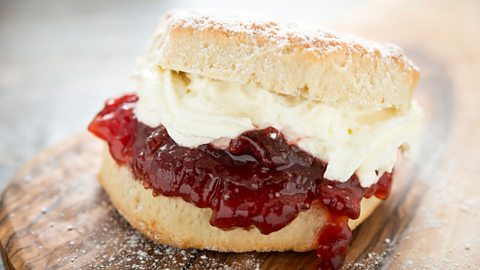
Cream teas: jam first or cream first?
The age-old debate of cream or jam first on a scone.
More from Radio 4
-
![]()
The Food Programme: Is the Pasty Really Cornish?
Dr Polly Russell and Sheila Dillon talk to pasty makers from around the world.
-
![]()
The biggest pie quiz ever
How much do you know about the world of pies and pastry encased culture?
-
![]()
Uncanny! It’s the great tinned food quiz
How much do you know about tins and their history? Take the quiz and find out…
-
![]()
How much do you know about these much-loved, barn-dwelling vehicles?


